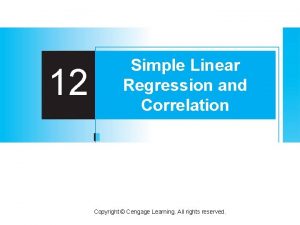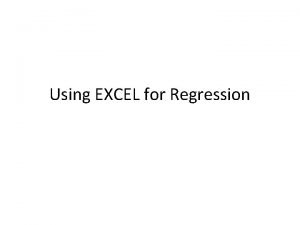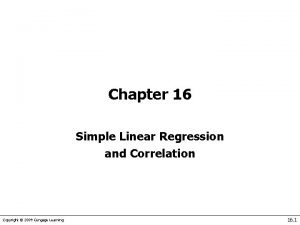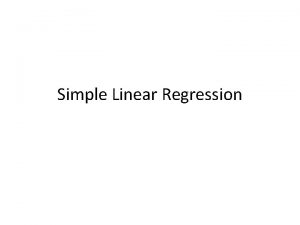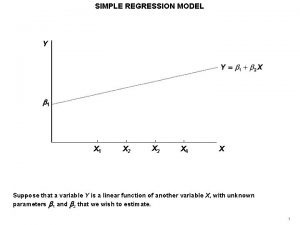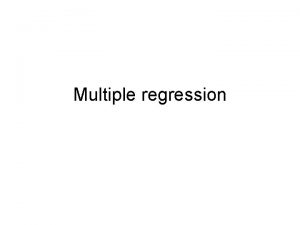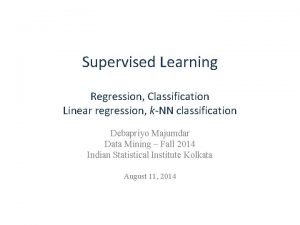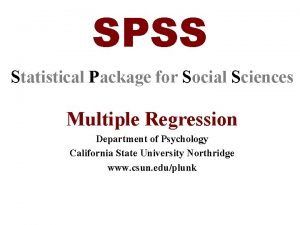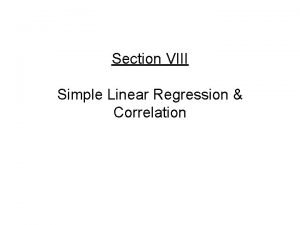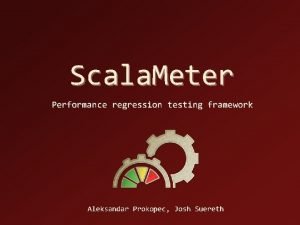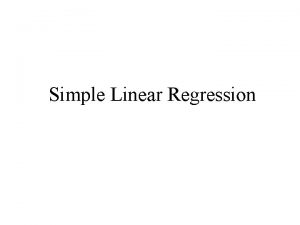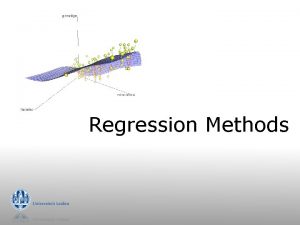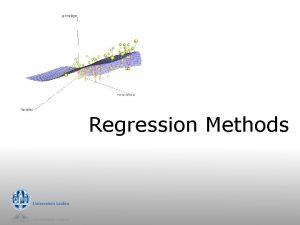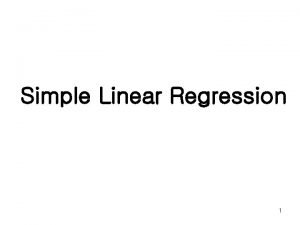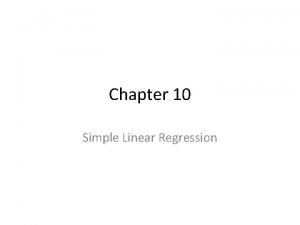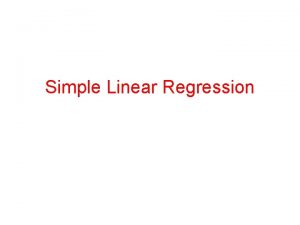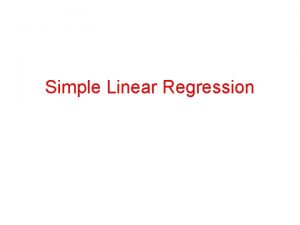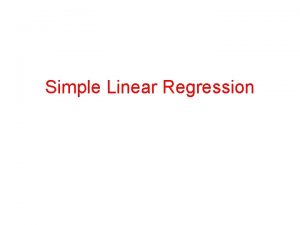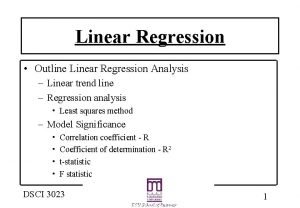Simple Regression An Overview and Simple Linear Regression
















- Slides: 16

Simple Regression: An Overview, and Simple Linear Regression Arzu Kalayci, MD

Introduction • Regression analysis is a reliable method identifying which explanatory variables have an impact on a response variable. • Multiple regression models can obtain adjusted effect estimates that take the effect of potential confounders into account. • Regression modeling is a universal tool for data analysis in epidemiology. • The most important methods are linear regression for continuous outcomes, logistic regression for binary outcomes, Cox regression for time-to-event data, and Poisson regression for frequencies and rates.

Basic Structure of a Simple Regression Model • The basic structure of simple regression models is a linear equation: – (Some function of an outcome) = intercept + (slope)*(x 1), i. e. , �� (�� ) = ���� + �� 1 – Where x 1 is a predictor of interest – (We’ll also see situations where a single predictor may need to be represented with more than a single x) – “Simple” refers to analyses with one predictor • We will also consider multiple regression, where there can be more than one predictor in a single model

Basic Structure: The Left-Hand Side -1 •

Basic Structure: The Left-Hand Side - 2 • The left-hand side (�� )) depends on what variable type the outcome of interest (�� ) is: – For time-to-event outcomes where the individual event and censoring times are not known, y is yes/no indicator of whether the event occurred in the common follow-up period; the left-hand side is �� n(incidence rate), and the regression type is Poisson regression – For time-to-event outcomes where the individual event and censoring times are known, y is a composite outcome taking into account both the time and whether the event occurred; the lefthand side is �� n(hazard rate), and the regression type is Cox regression

Basic Structure: The Right-Hand Side • The right-hand side, �� + �� �� 1, includes the predictor of interest, “�� 1 ” • This predictor of interest can be continuous, binary, or categorical (in which case, it will be represented by more than one �� )

Interpretations of Results When Predictor Is Binary • Suppose �� 1 is a binary predictor, such as sex (1 = female, 0 = male) – The resulting regression model is LHS = ���� + �� 1, where LHS = “left-hand side” • There are only two possible values �� 1: 1 (female), 0 (male) – When �� + �� 1 = 1: LHS = �� �� 1(1) = �� �� 1 – When �� + �� 1 = 0: LHS = �� �� 1(0) = �� �� • Interpretations: – �� = value of LHS when �� �� 1 = 0 (i. e. , for males) – �� 1= difference in value of LHS for �� 1 = 1, compared to �� 1 = 0 (i. e, for females compared to males)

Interpretations of Results When Predictor Is Nominal -1 • How to code �� when the predictor of interest is a nominal category, for example, clinic site (Hopkins, U of Maryland, U of Michigan) • For handling multiple nominal categories, the approach is to designate one of the groups as the “reference category” and create binary �� ’s for each of the other groups – For example, if we make Hopkins the reference, we will need additional variables: �� 1 = 1 if U of Maryland, 0 if not �� 2 = 1 if U of Michigan, 0 if not

Interpretations of Results When Predictor Is Nominal - 2 • The resulting model is LHS = ���� + �� 1 x 1 + �� 2 x 2, where LHS = “left-hand side” • The result for each possible combination of x 1 and x 2 values: – When �� + �� 1 = 0, �� 2 = 0: LHS = �� �� 1(0) = �� �� – When �� + �� 1 = 1, �� 2 = 0: LHS = �� �� 1(1) + �� 2(0) = �� �� 1 – When �� + �� 1 = 0, �� 2 = 1: LHS = �� �� 1(0) + �� 2(1) = �� �� 2

Interpretations of Results When Predictor Is Continuous • This is an efficient approach to handling measurements that are made continuously (age, height, etc. ) without arbitrarily having to categorize them (if the outcome/predictor association is well characterized by a line) – For example, suppose x 1 is age in years, and the regression equation is LHS = �� + �� �� 1 x 1 – How to interpret �� and �� �� 1?

The Intercept • The intercept, �� , is the value of left-hand side (LHS) when �� x 1 = 0 – It is the point on the graph where the line crosses the vertical (y) axis, at the coordinate (0, �� ) �� y = b +mx

The Slope -1 • The slope, �� 1, is the change in the left-hand side, corresponding to a unit increase in x 1

The Slope - 2 • The slope, �� 1, is the change in the left-hand side, corresponding to a unit increase in x 1: in other words, �� 1 is difference in the left-hand side for x 1 +1, compared to x 1 – This change/ difference is the same across the entire line

The Slope - 3 • All information about the difference in the left-hand side for two differing values of x 1 is contained in the slope! – For example: two values of x 1 three units apart will have a difference in left-hand side values of 3 ∗ �� 1

Summary • Regression is a general set of methods for relating a function of an outcome variable to a predictor via a linear equation of the form LHS = �� + �� �� 1 x 1, where LHS = “lefthand side” • Regardless of whether the predictor x 1 is binary, categorical, or continuous, – �� is the value of the LHS when x 1 (or all x’s if predictor is multi�� categorical) = 0 – �� 1 is the change in the value of LHS for a one-unit difference in x 1 (the difference in LHS for a one-unit difference in x 1)

THANK YOU
 Simple linear regression and multiple regression
Simple linear regression and multiple regression Logistic regression vs linear regression
Logistic regression vs linear regression Logistic regression vs linear regression
Logistic regression vs linear regression Multiple regression formula
Multiple regression formula Regression hypothesis
Regression hypothesis Regression analysis excel 2007
Regression analysis excel 2007 Simple linear regression
Simple linear regression Simple linear regression
Simple linear regression Simple linear regression model
Simple linear regression model Simple linear regression spss
Simple linear regression spss Knn linear regression
Knn linear regression Hierarchical linear regression spss
Hierarchical linear regression spss Linear regression riddle b
Linear regression riddle b Aleksandar prokopec
Aleksandar prokopec Multiple linear regression
Multiple linear regression Pengertian regresi linear
Pengertian regresi linear Multivariate regression spss
Multivariate regression spss




